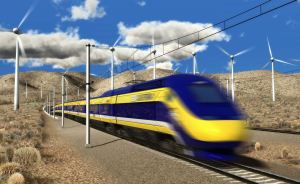
April 16, 2012
Last week, the board of the High-Speed Rail Authority adopted the latest business plan for a fast train through California. Dan Richard, the charismatic new chairman of the authority, won well-deserved kudos for working quickly to make a weak plan released last November strong enough to win broader support.
The new business plan, redrafted in just two months, calls for investing more and earlier in some local rail systems that will link to the planned high-speed system. This will provide improvements to people who commute around the Bay Area, through parts of Los Angeles County, and between the north end of the San Joaquin Valley and the Bay.
But the plan still fails on other counts that must keep environmentalists, including Sierra Club California, on high alert. The unaddressed environmental problems include a route that passes between the Central Valley and the Bay Area through the Pacheco Pass. The pass holds some of the largest inland natural wetlands in the state, and important bird and other wildlife habitat. The train route is expected to disturb wildlife and induce sprawl development there.
The route from Los Angeles to San Francisco, via the San Joaquin Valley and the South Bay Peninsula, also will displace rural and urban neighborhoods in parts of the San Joaquin Valley and in the Bay Area, and it will split farmland. Air pollution impacts are unclear, but the authority has promised to provide more information later this month.
Outside of environmental issues, the rail project still has substantial financing and management challenges. What was once expected to be a $40 billion project, but ballooned to nearly $100 billion in the November plan, has declined to just under $70 billion in the latest document, partly by lowering expected inflation rates.
Narrowly speaking, the finance issue isn't an environmental concern. Yet the authority's finance plan could prevent other environmentally favorable projects from occurring.
The authority assumes the federal government will heavily chip in funds to build the rail over the next 10 to 15 years. It's hard to fathom that will happen considering politics and budget woes in DC. But if it does, will there be any federal money left for California's other needs, including transit buses and light rail?
If the feds don't provide all that hoped-for rail funding, then the authority plans to dip into state revenues collected from greenhouse gas emissions credit auctions. The first of those auctions will occur in November. Some estimate the auctions could yield tens of billions of dollars in new money for the state over several years. But they might not. It’s all new ground.
Whatever money the auctions do generate, will have to be spent according to guidelines in AB 32, the Global Warming Solutions Act. Generally, that means spending to get the most environmental benefits. This begs the question: Is spending that auction money on high-speed rail the best way to use those funds to reduce global warming pollution ASAP?
The governor wants the legislature to appropriate $2.7 billion to accompany a $3.3 billion Federal Recovery Act grant to build the first stretch of the new rail from north of Fresno to north of Bakersfield. He wants the money appropriated from 2008 Prop. 1A bonds by June 15, the budget deadline. A few senators are saying not so fast.
Senator Joe Simitian, whose legislative district is on the Peninsula that will host part of the rail route, has told the press and others that he wants to take up the appropriation issue in August, outside of the budget process. He wants the public, especially, to have more time to review a raft of technical documents that accompanied the business plan, but were released just a day before the plan’s adoption.
If holding off a few months will help clarify outstanding issues, then so be it, Simitian says. He and other senators worry whether there is a management entity that can successfully oversee construction of this mega-project. That’s an issue that the authority's peer-review committee of transportation experts has raised, too.
One of the oft-repeated phrases I've heard in Sacramento in the last six months from environmentalists, rail advocates, legislators, and a range of policy wonks is "I support high-speed rail, but…."
Sierra Club generally supports high-speed rail, and in 2008, Sierra Club California specifically endorsed the successful ballot measure, Proposition 1A, that authorized nearly $10 billion of state bond investment in a high-speed rail system. The bond campaign promised to build a system that would get travelers from Los Angeles to San Francisco in 2 hours and 40 minutes, without having to step foot into an airplane.
But we are concerned about the California project, as we expressed in two letters earlier this year. This latest plan begins to address some of those concerns, but not enough to start celebrating. A lot of questions remain outstanding.
Dan Richard is a master at marshalling resources and inspiring smart people to achieve good work fast. This latest business plan is an example. I'm confident that given another four months, he will address the unanswered environmental questions. And I hope he'll be able to do it forthrightly, without creating environmental loopholes big enough to run a train through.
Sincerely,

Kathryn Phillips
Director
Sierra Club California is the Sacramento-based legislative and regulatory advocacy arm of the 13 California chapters of the Sierra Club.
Please consider becoming a sustaining donor.